|
|
|
Sort Order |
|
|
|
Items / Page
|
|
|
|
|
|
|
| Srl | Item |
| 1 |
ID:
191104
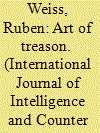

|
|
|
|
|
| Summary/Abstract |
This article seeks to examine the double agent from a literary perspective, focusing on how two spy novels set during the Cold War era—Tinker Tailor Soldier Spy (1974) by John le Carré and The Untouchable (1997) by John Banville—associate the double agent with the world of art. In spy novels set during the Cold War era, using the art world as a setting can provide a divided sense of self and the double agent’s struggle toward inner completeness. Ultimately, this struggle ends in failure.
|
|
|
|
|
|
|
|
|
|
|
|
|
|
|
|
| 2 |
ID:
191086
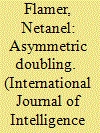

|
|
|
|
|
| Summary/Abstract |
As part of its intelligence warfare against Israel, Hamas made the identification and targeting of collaborators with Israel a top priority. During those years, the Hamas practice was to apply different degrees of detention and torture of those suspected of collaborating. However, in some cases, Hamas chose a different tactic of exploiting collaborators to transform a threat into an opportunity. Hamas turned some collaborators into double agents, using them to advance its objectives. This article examines some of the doubling operations carried out by Hamas on Israeli collaborators over the last three decades. Examining these cases reveal how Hamas’s doubling methods developed over time, concurrently with the movement’s evolution. Thus, the doubling operations became more organized and sophisticated, being used for propaganda and deterrence purposes as well as other goals. The article explores an interesting aspect of Hamas’s counterintelligence activity in its struggle against the state of Israel. In addition, it sheds light on how a nonstate organization can use doubling of sources as part of its asymmetric war against a state.
|
|
|
|
|
|
|
|
|
|
|
|
|
|
|
|
| 3 |
ID:
191087
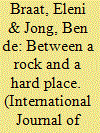

|
|
|
|
|
| Summary/Abstract |
While scholarly literature has paid attention to human intelligence professionalism from the perspective of the agent handler, we know relatively little about the precarious positions in which (double) agents often find themselves and what their ensuing needs from their handlers consist of. This article suggests that (double) agents desire a reciprocal, affect-based relationship with their handlers, involving trust and gratitude, more than just a negotiated relationship based on (financial) agreements. This article explains the importance of such a relationship. The main source of this research consists of original, in-depth oral history interviews with former double agent “M.” He operated from the 1960s through the 1990s for the Dutch Security Service and the Central Intelligence Agency against the East German Ministerium für Staatssicherheit. The article analyzes the varying degrees of appreciation that these services showed for his work, and it investigates their consequences on the psychological well-being of the double agent.
|
|
|
|
|
|
|
|
|
|
|
|
|
|
|
|
| 4 |
ID:
191083


|
|
|
|
|
| Summary/Abstract |
The Israeli General Security Services, commonly known as the Shabak, is responsible for counterintelligence inside Israel. In the 1960s, the Shabak was struggling to counter the operations of Russian intelligence in Israel. Committee for State Security (KGB) case officers, working under diplomatic cover from the Russian embassy in Tel Aviv, recruited and ran agents in Israel. The Shabak was able to turn some of those recruited by the KGB into double agents. These double agents were used to learn about KGB tradecraft, identify Russian intelligence operatives, and feed the Soviets harmless or false information, known as “chickenfeed.” This article examines the recruitment and running of two Shabak double agents, their value for the KGB, and unique aspects of Israeli double agent tradecraft. It concludes that Israeli double agents were good for tactical purposes, learning about enemy intelligence personnel and practices, but were not of high value when used as part of strategic deceptions.
|
|
|
|
|
|
|
|
|
|
|
|
|
|
|
|
| 5 |
ID:
191084
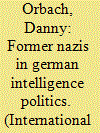

|
|
|
|
|
| Summary/Abstract |
The early history of the postwar West German foreign intelligence service is replete with accounts of former Nazi security officers who were recruited by the newly founded service thanks to their professional experience, connections, and anti-Soviet credentials, only to later be exposed as Soviet moles. Focusing on the case of Heinz Felfe, this article puts forward the argument that the reaction of a secret service to the impending exposure of moles can be even more harmful than their actual activity. Enemy moles in intelligence organizations are dangerous in more than one way. They cause damage, of course, when they operate in the dark, but also cause just as much, and even more, damage when exposed. The fear of public scandal incentivizes irrational behavior, aggravating rather than decreasing the dangers facing the service.
|
|
|
|
|
|
|
|
|
|
|
|
|
|
|
|
| 6 |
ID:
191105
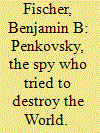

|
|
|
|
|
| Summary/Abstract |
Central Intelligence Agency (CIA) lore and popular culture tout Col. Oleg Penkovsky as “the spy who saved the world” during the Berlin and Cuban missile crises. In fact, his contribution to U.S. intelligence and policymaking is exaggerated, distorted, and in several instances falsified. More disturbing, Penkovsky harbored a murderous rage against the Soviet system and repeatedly tried to inveigle the West in a quixotic quest to destroy it. He devised a plan to blow up Moscow, advocated preventive war against the Soviet Union, fanned the flames of the Berlin crisis with false reports of Kremlin mobilization for war, and recommended assassinating Soviet leader Nikita Khrushchev. Penkovsky allegedly provided critical information that bought time for President John F. Kennedy to devise a diplomatic solution to the Cuban crisis before Soviet missiles were ready to fire. Not true, according to the president’s advisers. New information reveals that some Soviet missiles were combat-ready two days before U.S. intelligence discovered the first incomplete launch site. The State Committee for Security (KGB) allowed Penkovsky to continue spying for at least ten months after he came under suspicion, perhaps to protect a mole in American or British intelligence. A senior CIA officer claimed that, meanwhile, the Soviets controlled and manipulated Penkovsky without his knowledge. Even after his arrest, Penkovsky may have attempted to instigate a nuclear war by tricking the KGB into sending a false alert of an impending Soviet surprise attack on the United States.
|
|
|
|
|
|
|
|
|
|
|
|
|
|
|
|
| 7 |
ID:
191088


|
|
|
|
|
| Summary/Abstract |
In 1943, Ormond Uren, an army officer employed in the London headquarters of Britain’s Special Operations Executive, was court-martialed and imprisoned after disclosing secret information to a senior member of the Communist Party of Great Britain. The episode has become a staple of writers interested in tales of espionage and questions of loyalty, with Uren’s actions routinely presented as those of a spy and traitor. Drawing on MI5 records and other sources, this article argues that those routine images lack convincing evidence to support them; but it also demonstrates that the case retains importance as an example of the risks that secret organizations run when employees’ loyalties lie elsewhere.
|
|
|
|
|
|
|
|
|
|
|
|
|
|
|
|
| 8 |
ID:
191085


|
|
|
|
|
| Summary/Abstract |
In 1952–1957, Soviet counterintelligence launched operation METEOR in Latvia, reacquired by the USSR during World War II. Based on a wide net of double agents in the local anti-Soviet resistance, that clandestine enterprise aimed at convincing Washington to halt its intelligence and influence activities on Latvian soil. The Russian, Latvian, and Western sources have expressed varied, at times polarly opposed, assessments of METEOR’s actual effectiveness. This article uses newly acquired relevant American and Soviet sources to create a balanced picture of the U.S.–Soviet clandestine encounter in Latvia in the 1950s. Especially highlighted is the implementation on Latvian soil of the Soviet theory of strategic counterintelligence and deception operations based on double agents. Encouraged by its ability to recover METEOR’s principal stages—successful evolvement, efficacy’s zenith, and subsequent decline—the article proposes future theoretical inquiry into the paradoxical logic of intelligence and counterintelligence victorious operations and particularly into the notion of those operations’ “culmination points.”
|
|
|
|
|
|
|
|
|
|
|
|
|
|
|
|
|
|
|
|
|